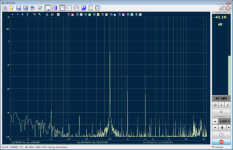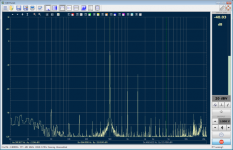Further test done with a arbitrary waveform generator feeding CLIO Pocket. The test confirms THD-%/dB meter uses only 2nd harmonic. 🙁
From left to right
First figure: fundamental (500 Hz) and second harmonic
Second figure: fundamental, second & fourth harmonic
Third figure: fundamental, second & third harmonic
Value shown by the THD-dB meter barely unchanged.
From left to right
First figure: fundamental (500 Hz) and second harmonic
Second figure: fundamental, second & fourth harmonic
Third figure: fundamental, second & third harmonic
Value shown by the THD-dB meter barely unchanged.
Attachments
Last edited:
Pitty that it lacks a better distorsion analyzer and presentation otherwise it looks very good to me! Is it possible that audiomatica Will release à more advanced software for the pocket hardware? Clio pocket PRO?
I hope so. But that may threaten the big CLIO. Both of them are essentially sound card + software. How about API, LabView/Matlab driver?
Maybe so, but a full blown clio pocket pro software would still not get you as much as the big clio, the pocket hardware is still not as advanced as the biggo clio?
For the LogChirp measurement signal, is it possible to set the played freqency bandwidth like start (and stop) frequency? This to protect tweeters when measured bared
Yes, use the Generator Control. On the lower right side of the screen, there's a set of Output controls. Click the down arrow on the right and it will bring up the Generator Control screen.
It does measure distortion.
Hi can you guide me on measuring THD using Clio pocket, i tried the system by sending sin and measuring FFT i could see the harmonics but how can we quantify them in percentage? thanks
Convert dB to level with respect to the fundamental. For example, if a dominant harmonic is 40 dB down, it's 1%. Many find dB more useful than percent, take your choice.
Yes, use the Generator Control. On the lower right side of the screen, there's a set of Output controls. Click the down arrow on the right and it will bring up the Generator Control screen.
It only changes the freq. range (start or stop) when you use the generator independently. It doesn't change the lower and upper freq. when you use logchirp to make measurement (imp, SPL, dbV, etc.). I am using rel.1.4.1 software.
Last edited:
It only changes the freq. range (start or stop) when you use the generator independently. It doesn't change the lower and upper freq. when you use logchirp to make measurement (imp, SPL, dbV, etc.). I am using rel.1.4.1 software.
Hello panson, what changes in 1.42 Clio update.
I've updated from v1.41 to v1.42.
I've not detected differences, they may be minor.
I am now accustomed to Clio Pkt and mainly use it. With great satisfaction.
But the graphic interface needs to be made much more handy,
that's not difficult for a good programmer to do it.
I've not detected differences, they may be minor.
I am now accustomed to Clio Pkt and mainly use it. With great satisfaction.
But the graphic interface needs to be made much more handy,
that's not difficult for a good programmer to do it.
Can't speak for CLIO pocket, but I've found CLIO 10&11 the most akward piece of SW I've ever had to use (maybe except Audio Precision). The hardware is quite fine, but the software limits the usefulness of the system big time. I really hate to use it.
I've updated from v1.41 to v1.42.
I've not detected differences, they may be minor.
I am now accustomed to Clio Pkt and mainly use it. With great satisfaction.
But the graphic interface needs to be made much more handy,
that's not difficult for a good programmer to do it.
Yes, I find more or less the same. The only difference is language select for help shown at first run of the software.
Can't speak for CLIO pocket, but I've found CLIO 10&11 the most akward piece of SW I've ever had to use (maybe except Audio Precision). The hardware is quite fine, but the software limits the usefulness of the system big time. I really hate to use it.
I agree for both CLIO 11 and Pocket. Firewire connection was unstable too. We tried many PC config.
Can't speak for CLIO pocket, but I've found CLIO 10&11 the most akward piece of SW I've ever had to use (maybe except Audio Precision). The hardware is quite fine, but the software limits the usefulness of the system big time. I really hate to use it.
The Clio system we have sits in a corner disintegrating because its difficult to use and not as flexible as we need. Its a shame but not much we can do. The other acoustic stuff is just easier and quicker for our needs.
The Clio system we have sits in a corner disintegrating because its difficult to use and not as flexible as we need. Its a shame but not much we can do. The other acoustic stuff is just easier and quicker for our needs.
please elaborate, what other acoustic stuff?
We use Praxis for most of the acoustic work. We test all parameters of headphones and need some pretty special configurations to measure things like noise reduction of ANC or acoustic phase shift from outside to inside a headphone.
We also have a CRY setup to match typical production headphone test systems.
We also have a CRY setup to match typical production headphone test systems.
I just realized that the CLIO Pocket THD-% or THD-dB meter seems to take only second harmonic in to account...
Hello Everyone:
Sorry I just saw this discussion, but I'd like to set the record straight about CLIO Pocket's THD measurements. They are spot on. You just have to hit the bucket correctly - the same as with any other FFT based distortion measurement. 🙂
The bucket I'm referring to is actually called a FFT bin. A FFT measurement is made up of hundreds of these bins that "catch" the magnitude and phase data from the FFT transform. Then it's just connect-the-dots from bin to bin to draw the trace on your screen.
If you choose a frequency that doesn't hit the center of a bin, that fundamental or harmonic will miss the bin (or be sliced by the windowing into a smaller, thus under-represented sample) and you'll get an understated THD measurement.
Audio Precision vs. CLIO Pocket THD
View attachment CLIO Pocket THD Accuracy.pdf
YouTube Video
CLIO Pocket THD Measurement
Last edited:
- Home
- Design & Build
- Equipment & Tools
- CLIO Pocket


